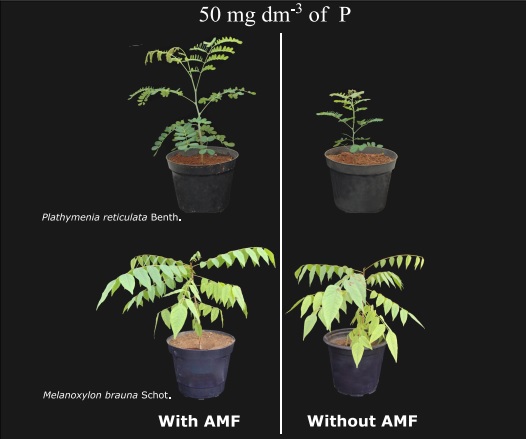Mycorrhizal inoculation and phosphorus fertilization show contrasts on native species of the Brazilian Atlantic Forest and Cerrado
09/Sep/2021
ABSTRACT Restoration of degraded sites by using native plants like Plathymenia reticulata Benth. and Melanoxylon brauna Schot. is advisable. However, seedlings of both species, when raised on commercial substrates, may present low survival. This study aimed to evaluate the growth of seedlings under inoculation with arbuscular mycorrhizal fungi (AMF). The seedlings were raised on soil sampled from near an adult plant of the same species. The P. reticulata and M. brauna seedlings were grown with or without the inoculation of […]
Isolation, Characterization and Symbiotic Efficiency of Nitrogen-Fixing and Heavy Metal-Tolerant Bacteria from a Coalmine Wasteland
05/Sep/2018
ABSTRACT: Areas affected by coal mining can be recovered by revegetation with leguminous plants associated with nitrogen-fixing bacteria. This study addressed the isolation and characterization of native nitrogen-fixing bacteria from coalmine wasteland under different vegetation restoration approaches using Macroptilium atropurpureum (DC) Urb and Vicia sativa L. as trap plants. The bacteria were characterized and identified on the basis of 16S rRNA sequences. Additionally, nitrogen-fixing strains were characterized for tolerance to high heavy metal and low pH levels, as well as […]
In-furrow inoculation of soybean as alternative to fungicide and micronutrient seed treatment
01/Aug/2010
Soybean is a major grain crop in Brazil, and yields can be considerably improved by inoculation with selected Bradyrhizobium strains. However, the incompatibility between inoculation and seed treatments with fungicides and micronutrients represents a major barrier to the achievement of high rates of biological N2 fixation. Inoculation practices that can alleviate the negative effects of agrochemicals must therefore be found and in-furrow inoculation seems to be an attractive alternative. This study reports the results of seven field experiments conducted in […]
Forms of inoculant application and effects on soybean nodulation
01/Apr/2008
Nowadays, inoculant application in the sowing furrow of soybean is widely used, but there is little information underlying this practice, which would prove the efficiency in different environments under no-tillage systems. This study aimed to evaluate the viability of inoculant application to soybean, via seed and in-furrow, in soil never cultivated with soybean or previously cultivated with soybean. Two field experiments were carried out as of December 2004 in a Red Yellow Latosol (Oxisol), using the same methodology and applying […]
Agronomic efficiency of selected rhizobia strains and diversity of native nodulating populations in Perdões (MG – Brazil). I – cowpea
01/Oct/2006
Cowpea (Vigna unguiculata L.) is one of the main food crops in the north and northeast of Brazil nowadays, being planted on large areas in other Brazilian regions as well, with bright prospects in the Brazilian agribusiness. Symbiosis of cowpea and nitrogen-fixing bacteria (NFB) can raise yields and decrease yield costs. The first aim of this study was to evaluate the agronomic efficiency of previously selected rhizobia strains compared to the strain recommended until 2004 (BR 2001). The phenotypic diversity of […]
Agronomic efficiency of selected rhizobia strains and diversity of native nodulating populations in Perdões (MG – Brazil). II – beans
01/Oct/2006
Common bean (Phaseolus vulgaris L.) is an economically and socially highly relevant staple food and an excellent protein source for the Brazilian population. Symbiosis of beans and N2 fixing bacteria can increase yields and decrease yield costs. The first aim of this study was to evaluate the agronomic efficiency of previously selected rhizobia strains compared to the recommended strain (CIAT 899). Phenotypic diversity of rhizobia native populations was evaluated by cultural characteristics and analysis of total protein profiles by polyacrilamide gel […]
Growth and nodulation of Acacia mangium, Enterolobium contortisiliquum and Sesbania virgata in heavy metal contaminated soil
01/Sep/2001
One of the great challenges in environmental research today is to find tolerant species of plants and microsymbionts to make viable the revegetation of contaminated areas with heavy metals. This experiment was carried out under greenhouse conditions at the Soil Science Department of the Federal University of Lavras (MG), from August to December 1998, to assess the tolerance to heavy metals and the capacity to establish rhizobia symbiosis with Enterolobium contortisiliquum (tamboril), Acacia mangium (acacia) and Sesbania virgata (sesbânia) in […]
Effects of peat inoculant doses on biological nitrogen fixation by soybean crop
01/Sep/2000
Soybean [Glycine max (L.) Merrill] inoculation and reinoculation are essential to guarantee the maximization of the biological N2 fixation process. Most inoculants commercialized for soybean in Brazil are peat-based, but there are doubts about the dose of peat inoculant which should be recommended, specially under stressing conditions or in areas previously inoculated. Therefore, for the central region of Brazil, the recommendation is 1.000 g of inoculant/50 kg of seeds, with a sugar cane solution as adhesive. However, in this study […]
Effects of concentrations of sugar cane solution on the adhesion of peat-based inoculant to the seeds, on the nodulation and soybean yield
01/Sep/2000
Soybean [Glycine max (L.) Merrill] plants establish a symbiosis with bacteria belonging to the genus Bradyrhizobium, realizing the biological N2 fixation process. The inoculation with selected rhizobial strains guarantees the maximization of the biological process. In Brazil, almost 13 million doses of inoculants, mainly peat based, are commercialized annually. However, the peat adhesion to the soybean seeds is low, requiring the use of adhesives. The current recommendation is the use of a water sugar cane solution at 25%, but this […]

